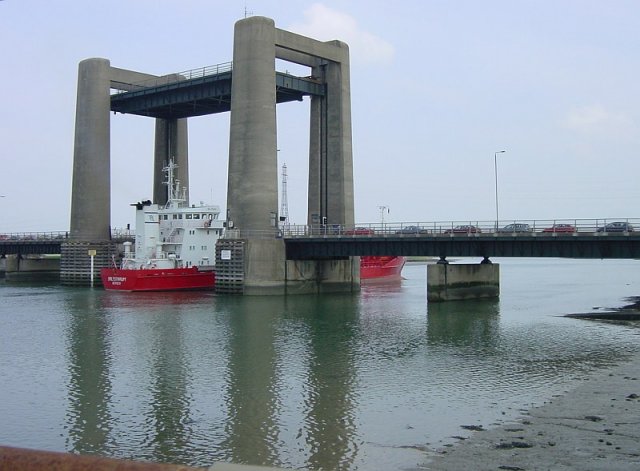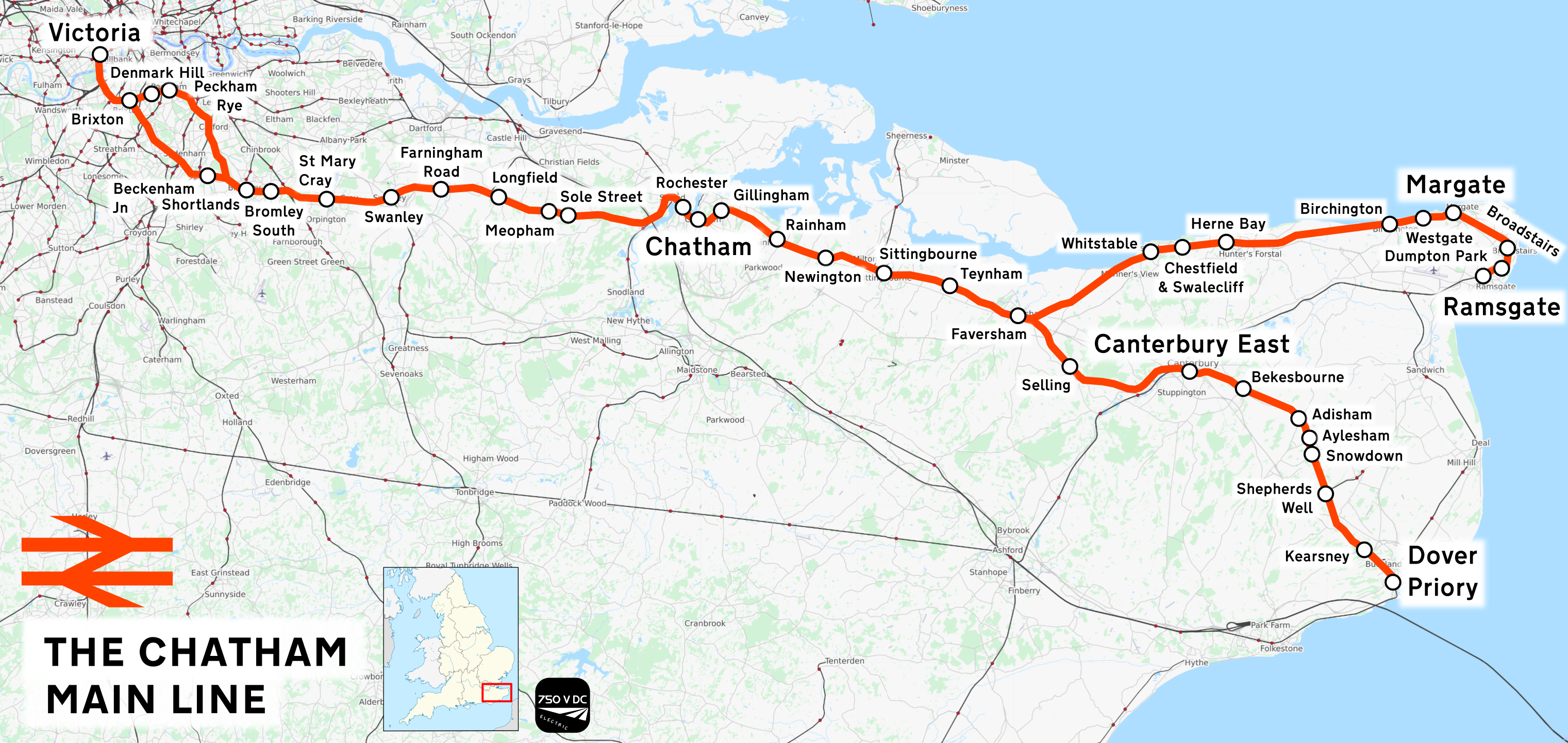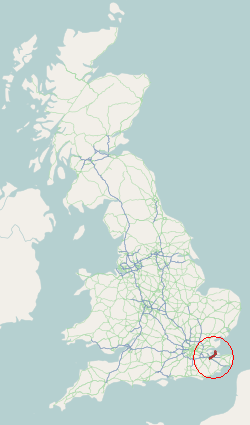|
Bobbing, Kent
Bobbing is a village and civil parish in the Swale district of Kent, England, about a mile north-west of Sittingbourne, and forming part of its urban area. The hamlet of Howt Green and village of Keycol are included within the parish. According to the 2011 census Bobbing parish had a population of 1,969. The parish of Bobbing, according to Edward Hasted in 1800, contains about seven hundred and eighty acres of land, of which forty were wood. The mediaeval manor house of Bobbing Court, now a Grade II listed ruin, was built by the Savage family; it passed to the distinguished soldier Sir Conyers Clifford, and then by marriage into the St. Leger family. The village church, St Bartholomew, is a grade I listed building. It is within the diocese of Canterbury and deanery of Sittingbourne. According to Edward Hasted in 1798, the church consisted of two small aisles and two chancels, having a tall spire steeple at the west end of it, in which are five bells. The strange career of T ... [...More Info...] [...Related Items...] OR: [Wikipedia] [Google] [Baidu] |
Borough Of Swale
Swale is a local government district with borough status in Kent, England and is bounded by Medway to the west, Canterbury to the east, Ashford to the south and Maidstone to the south west. Its council is based in Sittingbourne. The district is named after the narrow channel called The Swale, that separates the mainland of Kent from the Isle of Sheppey, and which occupies the central part of the district. The district was formed in 1974 under the Local Government Act 1972, from the Borough of Faversham; the Borough of Queenborough-in-Sheppey, which covered the whole of Sheppey; the Sittingbourne and Milton Urban District; and Swale Rural District. Most of the southern half of the Borough lies within the Kent Downs Area of Outstanding Natural Beauty, whilst Sittingbourne and the Isle of Sheppey forms the concluding part of the Thames Gateway growth area. There are four towns in the borough: Sittingbourne and Faversham on the mainland, and Sheerness and Queenborough on S ... [...More Info...] [...Related Items...] OR: [Wikipedia] [Google] [Baidu] |
Conyers Clifford
Sir Conyers Clifford (c. 1566 – 1599) was an English politician and military commander. Life and career He was the son of George Clifford, esq., of Bobbing Court in Kent, by his wife Ursula, daughter of Roger Finch. His elder brother, Henry Clifford, Esq., alienated the manor of Bobbing to Conyers. Conyers Clifford served in the army sent under Robert Devereux, 2nd Earl of Essex to the siege of Rouen in 1591, being then a captain. He and John Wotton especially distinguished themselves in rescuing from the enemy the dead body of the earl's brother, Walter Devereux, who had fallen into an ambush during a demonstration before Rouen. In the same year, Clifford was knighted. He represented the borough of Pembroke in the parliament which met on 19 February 1593. At the bachelors' commencement in 1595 the University of Cambridge conferred on him the degree of M.A. On the news being received of the siege of Calais by the Spanish, the Earl of Essex pushed to Dover; he wrote to S ... [...More Info...] [...Related Items...] OR: [Wikipedia] [Google] [Baidu] |
Villages In Kent ...
__NOTOC__ See also *List of settlements in Kent by population * List of civil parishes in Kent * :Civil parishes in Kent * :Towns in Kent * :Villages in Kent * :Geography of Kent *List of places in England {{Kent Places Kent Kent is a county in South East England and one of the home counties. It borders Greater London to the north-west, Surrey to the west and East Sussex to the south-west, and Essex to the north across the estuary of the River Thames; it faces ... [...More Info...] [...Related Items...] OR: [Wikipedia] [Google] [Baidu] |
Chatham Main Line
The Chatham Main Line is a railway line in England that links London VictoriaQuail Map 5 – England South ages 2–13Sept 2002 (Retrieved 14 December 2011) and Dover Priory / Ramsgate, travelling via Medway (of which the town of Chatham is part, hence the name). Services to Cannon Street follow the route as far as St Mary Cray Junction where they diverge onto the South Eastern Main Line near Chislehurst. Thameslink services to Luton run in parallel from Rainham to Rochester, diverging once across the River Medway at Rochester Bridge Junction onto the North Kent Line via Gravesend and Dartford. A shuttle service operates on the Sheerness Line which starts at Sittingbourne. Services Most services on the Line are run by SE Trains and Southern. Govia Thameslink Railway run some Thameslink services, the first starting from and travelling via on the Catford Loop, joining at Shortlands Junction, travelling to before heading to . The second service starts from and also ... [...More Info...] [...Related Items...] OR: [Wikipedia] [Google] [Baidu] |
A249 Road
The A249 is a road in Kent, England, running from Maidstone to Sheerness on the Isle of Sheppey. It mainly functions as a link between the M2 and M20 motorways, and for goods vehicle traffic to the port at Sheerness. In 2006 an upgraded dual carriageway section opened between Iwade and Queenborough, including a new fixed crossing over the Swale. The existing lifting Kingsferry Bridge has been retained as an alternative route. On 5 September 2013 more than 100 vehicles were involved in an accident on the crossing. Route The A249 begins close to Maidstone town centre, where it commences by heading eastwards from the southbound A229 Lower Stone Street along first Mote Road and then along Wat Tyler Way. Due to Maidstone's one-way system, the westbound carriageway extends along for a short way along Knightrider Street (towards the Archbishop's Palace, Maidstone) before it then ends, as it meets the northbound carriageway of the A229. At the top of Wat Tyler Way, where that roa ... [...More Info...] [...Related Items...] OR: [Wikipedia] [Google] [Baidu] |
Cremation Society Of Great Britain
The Cremation Society of Great Britain (now known as The Cremation Society) was founded in 1874 to promote the use of cremation as an alternative means of dealing with the bodies of the dead instead of burial which until then was the only option. Today the society is a registered charity and is not conducted for profit. Early history In Europe, a movement to reintroduce cremation as a viable method for body disposal began in the early 1870s. This was made possible by the invention of new furnace technology and contact with Eastern cultures that practiced it. At the time, many proponents believed in the miasma theory, and that cremation would reduce the "bad air" that caused diseases. In 1869, the idea was presented to the Medical International Congress of Florence by Professors Coletti and Castiglioni "in the name of public health and civilization". In 1873 Professor Paolo Gorini of Lodi and Professor Ludovico Brunetti of Padua published reports of practical work they had conducte ... [...More Info...] [...Related Items...] OR: [Wikipedia] [Google] [Baidu] |
Popish Plot
The Popish Plot was a fictitious conspiracy invented by Titus Oates that between 1678 and 1681 gripped the Kingdoms of England and Scotland in anti-Catholic hysteria. Oates alleged that there was an extensive Catholic conspiracy to assassinate Charles II, accusations that led to the executions of at least 22 men and precipitated the Exclusion Bill Crisis. Eventually, Oates's intricate web of accusations fell apart, leading to his arrest and conviction for perjury. Background Development of English anti-Catholicism The fictitious Popish Plot must be understood against the background of the English Reformation and the subsequent development of a strong anti-Catholic sentiment among the mostly Protestant population of England. The English Reformation began in 1533, when King Henry VIII (1509–1547) sought an annulment of his marriage to Catherine of Aragon to marry Anne Boleyn. As the Pope would not grant this, Henry broke away from Rome and took control of the Church in ... [...More Info...] [...Related Items...] OR: [Wikipedia] [Google] [Baidu] |
Titus Oates
Titus Oates (15 September 1649 – 12/13 July 1705) was an English priest who fabricated the " Popish Plot", a supposed Catholic conspiracy to kill King Charles II. Early life Titus Oates was born at Oakham in Rutland. His father Samuel (1610–1683), of a family of Norwich ribbon-weavers,Dictionary of National Biography, 1885–1900, vol. 41, Nichols-O'Dugan, ed. Sidney Lee, Macmillan & Co., 1895, p. 296 was a graduate of Corpus Christi College, Cambridge, and became a minister who moved between the Church of England (sometime rector of Marsham, Norfolk) and the Baptists; he became a Baptist during the English Civil War, rejoining the established church at the Restoration, and was rector of All Saints' Church at Hastings (1666–74). Oates was educated at Merchant Taylors' School and other schools. At Cambridge University, he entered Gonville and Caius College in 1667 but transferred to St John's College in 1669; he left later the same year without a degree. A less than ast ... [...More Info...] [...Related Items...] OR: [Wikipedia] [Google] [Baidu] |
Canterbury
Canterbury (, ) is a City status in the United Kingdom, cathedral city and UNESCO World Heritage Site, situated in the heart of the City of Canterbury local government district of Kent, England. It lies on the River Stour, Kent, River Stour. The Archbishop of Canterbury is the primate (bishop), primate of the Church of England and the worldwide Anglican Communion owing to the importance of Augustine of Canterbury, St Augustine, who served as the apostle to the Anglo-Saxon paganism, pagan Kingdom of Kent around the turn of the 7th century. The city's Canterbury Cathedral, cathedral became a major focus of Christian pilgrimage, pilgrimage following the 1170 Martyr of the Faith, martyrdom of Thomas Becket, although it had already been a well-trodden pilgrim destination since the murder of Ælfheah of Canterbury, St Alphege by the men of cnut, King Canute in 1012. A journey of pilgrims to Becket's shrine served as the narrative frame, frame for Geoffrey Chaucer's 14th-century Wes ... [...More Info...] [...Related Items...] OR: [Wikipedia] [Google] [Baidu] |
Grade II Listed
In the United Kingdom, a listed building or listed structure is one that has been placed on one of the four statutory lists maintained by Historic England in England, Historic Environment Scotland in Scotland, in Wales, and the Northern Ireland Environment Agency in Northern Ireland. The term has also been used in the Republic of Ireland, where buildings are protected under the Planning and Development Act 2000. The statutory term in Ireland is " protected structure". A listed building may not be demolished, extended, or altered without special permission from the local planning authority, which typically consults the relevant central government agency, particularly for significant alterations to the more notable listed buildings. In England and Wales, a national amenity society must be notified of any work to a listed building which involves any element of demolition. Exemption from secular listed building control is provided for some buildings in current use for worship, ... [...More Info...] [...Related Items...] OR: [Wikipedia] [Google] [Baidu] |
Kent
Kent is a county in South East England and one of the home counties. It borders Greater London to the north-west, Surrey to the west and East Sussex to the south-west, and Essex to the north across the estuary of the River Thames; it faces the French department of Pas-de-Calais across the Strait of Dover. The county town is Maidstone. It is the fifth most populous county in England, the most populous non-Metropolitan county and the most populous of the home counties. Kent was one of the first British territories to be settled by Germanic tribes, most notably the Jutes, following the withdrawal of the Romans. Canterbury Cathedral in Kent, the oldest cathedral in England, has been the seat of the Archbishops of Canterbury since the conversion of England to Christianity that began in the 6th century with Saint Augustine. Rochester Cathedral in Medway is England's second-oldest cathedral. Located between London and the Strait of Dover, which separates England from mainla ... [...More Info...] [...Related Items...] OR: [Wikipedia] [Google] [Baidu] |
Mediaeval
In the history of Europe, the Middle Ages or medieval period lasted approximately from the late 5th to the late 15th centuries, similar to the post-classical period of global history. It began with the fall of the Western Roman Empire and transitioned into the Renaissance and the Age of Discovery. The Middle Ages is the middle period of the three traditional divisions of Western history: classical antiquity, the medieval period, and the modern period. The medieval period is itself subdivided into the Early, High, and Late Middle Ages. Population decline, counterurbanisation, the collapse of centralized authority, invasions, and mass migrations of tribes, which had begun in late antiquity, continued into the Early Middle Ages. The large-scale movements of the Migration Period, including various Germanic peoples, formed new kingdoms in what remained of the Western Roman Empire. In the 7th century, North Africa and the Middle East—most recently part of the Eastern Roman ... [...More Info...] [...Related Items...] OR: [Wikipedia] [Google] [Baidu] |







